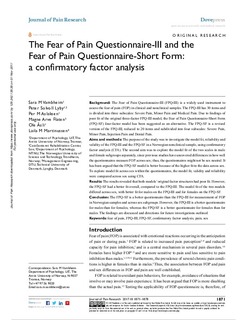| dc.contributor.author | Vambheim, Sara Magelssen | |
| dc.contributor.author | Lyby, Peter Solvoll | |
| dc.contributor.author | Aslaksen, Per M | |
| dc.contributor.author | Flaten, Magne | |
| dc.contributor.author | Åsli, Ole | |
| dc.contributor.author | Martinussen, Laila Marianne | |
| dc.date.accessioned | 2017-11-07T07:19:20Z | |
| dc.date.available | 2017-11-07T07:19:20Z | |
| dc.date.created | 2017-08-09T09:32:13Z | |
| dc.date.issued | 2017 | |
| dc.identifier.citation | Journal of Pain Research. 2017, 10 1871-1878. | nb_NO |
| dc.identifier.issn | 1178-7090 | |
| dc.identifier.uri | http://hdl.handle.net/11250/2464384 | |
| dc.description.abstract | Background: The Fear of Pain Questionnaire-III (FPQ-III) is a widely used instrument to assess the fear of pain (FOP) in clinical and nonclinical samples. The FPQ-III has 30 items and is divided into three subscales: Severe Pain, Minor Pain and Medical Pain. Due to findings of poor fit of the original three-factor FPQ-III model, the Fear of Pain Questionnaire-Short Form (FPQ-SF) four-factor model has been suggested as an alternative. The FPQ-SF is a revised version of the FPQ-III, reduced to 20 items and subdivided into four subscales: Severe Pain, Minor Pain, Injection Pain and Dental Pain.
Aims and methods: The purpose of the study was to investigate the model fit, reliability and validity of the FPQ-III and the FPQ-SF in a Norwegian nonclinical sample, using confirmatory factor analysis (CFA). The second aim was to explore the model fit of the two scales in male and female subgroups separately, since previous studies have uncovered differences in how well the questionnaires measure FOP across sex; thus, the questionnaires might not be sex neutral. It has been argued that the FPQ-SF model is better because of the higher fit to the data across sex. To explore model fit across sex within the questionnaires, the model fit, validity and reliability were compared across sex using CFA.
Results: The results revealed that both models’ original factor structures had poor fit. However, the FPQ-SF had a better fit overall, compared to the FPQ-III. The model fit of the two models differed across sex, with better fit for males on the FPQ-III and for females on the FPQ-SF.
Conclusion: The FPQ-SF is a better questionnaire than the FPQ-III for measurement of FOP in Norwegian samples and across sex subgroups. However, the FPQ-III is a better questionnaire for males than for females, whereas the FPQ-SF is a better questionnaire for females than for males. The findings are discussed and directions for future investigations outlined. | nb_NO |
| dc.language.iso | eng | nb_NO |
| dc.publisher | Dove Medical Press | nb_NO |
| dc.rights | Navngivelse-Ikkekommersiell 4.0 Internasjonal | * |
| dc.rights.uri | http://creativecommons.org/licenses/by-nc/4.0/deed.no | * |
| dc.title | The Fear of Pain Questionnaire-III and the Fear of Pain Questionnaire-Short Form: a confirmatory factor analysis | nb_NO |
| dc.type | Journal article | nb_NO |
| dc.type | Peer reviewed | nb_NO |
| dc.description.version | publishedVersion | nb_NO |
| dc.source.pagenumber | 1871-1878 | nb_NO |
| dc.source.volume | 10 | nb_NO |
| dc.source.journal | Journal of Pain Research | nb_NO |
| dc.identifier.doi | 10.2147/JPR.S133032 | |
| dc.identifier.cristin | 1485059 | |
| dc.description.localcode | This work is published and licensed by Dove Medical Press Limited. The full terms of this license are available at https://www.dovepress.com/terms.php and incorporate the Creative Commons Attribution - Non Commercial (unported, v3.0) License. | nb_NO |
| cristin.unitcode | 194,67,40,0 | |
| cristin.unitname | Institutt for psykologi | |
| cristin.ispublished | true | |
| cristin.fulltext | original | |
| cristin.qualitycode | 1 | |

